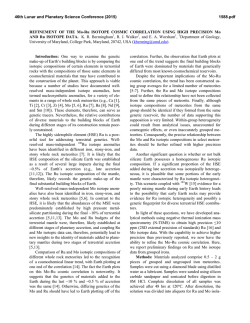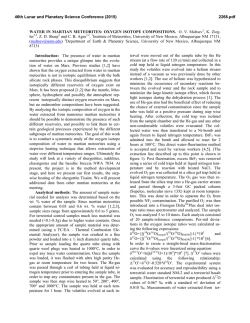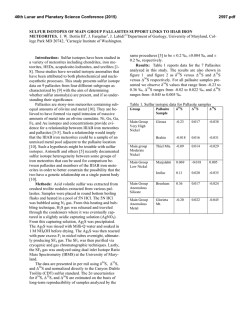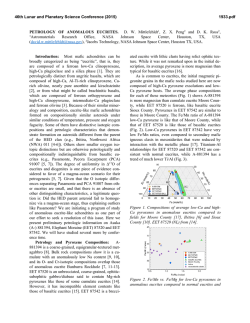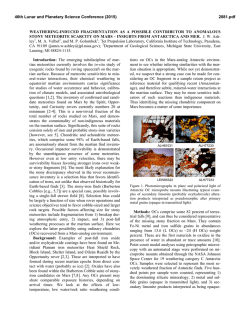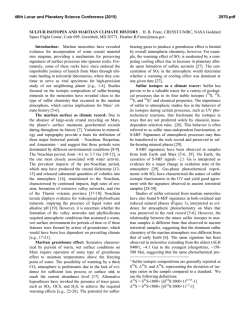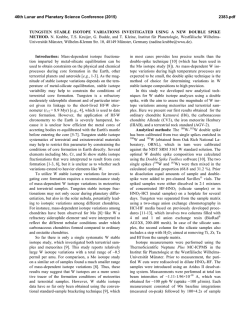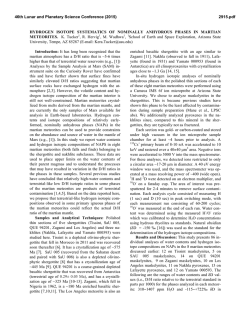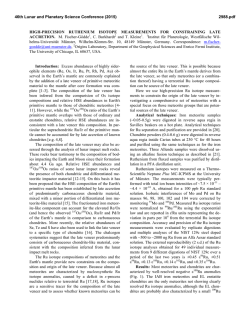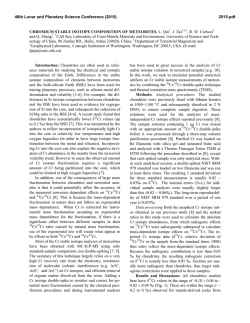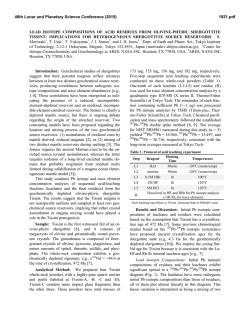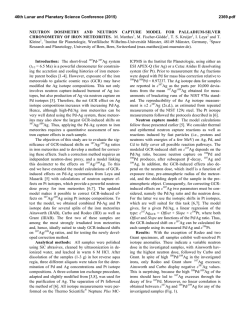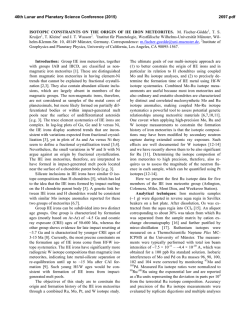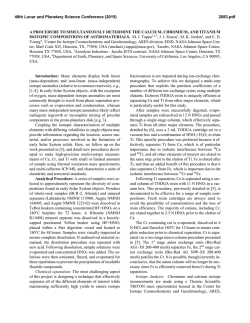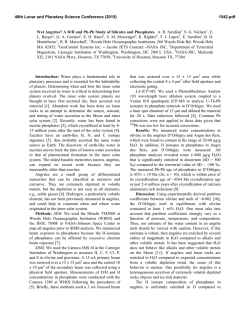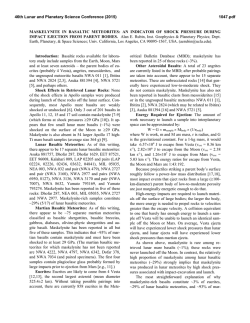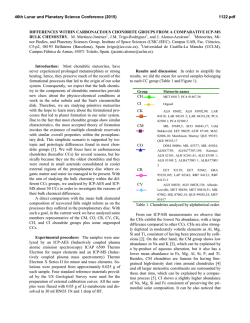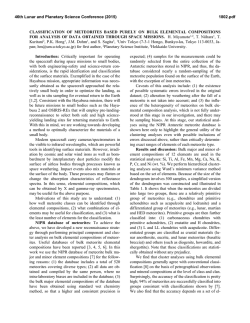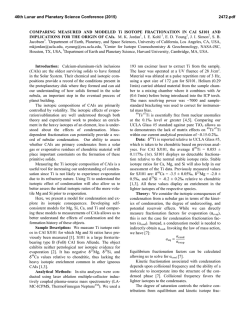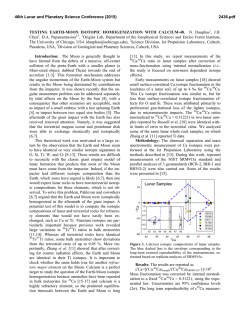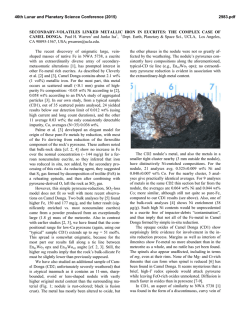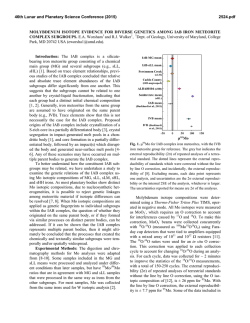
1671
46th Lunar and Planetary Science Conference (2015) 1671.pdf Ti-Cr-O ISOTOPE SYSTEMATICS OF THE ANOMALOUS EUCRITES AND MARTIAN METEORITES. C. D. Williams1, M. E. Sanborn1 and Q. –Z. Yin1, 1Department of Earth and Planetary Sciences, University of California at Davis, One Shields Avenue, Davis, CA 95616 USA. E-Mail: [email protected]. Introduction: Mass-independent isotope variations in bulk meteorites provide critical information regarding petrogenetic links among planetary materials (e.g., [1]). Recently, [2] suggested that the Cr isotopic composition of the anomalous eucrites coupled with the observed range of Δ17O may indicate a more complex history for these meteorites (and the eucrites in general) including the possibility of multiple parent bodies (in addition to 4 Vesta). The anomalous eucrites also indicate that a wide diversity of magmatic processes and parent bodies evolved contemporaneously over a wide spatial region in the early Solar System. Here, we continue our investigations using massindependent isotopic variations in bulk meteorites to further elucidate potential petrogenetic links among planetary materials. In particular, this study extends previous investigations into the anomalous eucrites (Asuka 881394, Ibitira, PCA 91007, Pasamonte, NWA 1240, Dhofar 007) by measuring their Ti isotopic compositions. Additionally, we report complementary Ti-Cr-O isotope systematics for one diogenite (Dhofar 700), six martian meteorites (Tissint, NWA 7034, Nakhla, Shergotty, Chassigny, NWA 8159) and an H7 chondrite (Watson 012). Analytical Methods: Small chips without fusion crusts were powdered using an agate mortar and pestle. The sample powders (~20-30 mg) were placed in PTFE Parr bomb capsules with a 3:1 mixture of concentrated HF and HNO3. Each sample was placed in an oven at 190°C for 96 hours for complete dissolution of refractory phases. The separation of Cr and determination of Cr isotope ratios was completed following the procedures described in [2,3]. Chromium isotope ratios were made using a Thermo Triton Plus thermal ionization mass spectrometer at the University of California at Davis (UC Davis). The typical intensity for 52Cr was 10 V in low resolution (using 1011 ohm resistors) for a 3 µg load of Cr. In the same sample solutions analyzed for Cr isotope ratios, Ti was separated from the matrix using a combination of cation and anion exchange chromatography following the methods of [4]. Titanium yields after processing through both cation and anion chromatography were greater than 98%. Titanium isotope ratios were measured with a Thermo Neptune Plus MC-ICPMS at UC Davis. A standard H-type skimmer cone was used, while a Jet sample cone was inserted in place of the standard sample cone. Typical intensity for 48Ti was 25 15 15 15 10 10 10 5 5 5 ±2SE -2.00 -1.50 -1.00 -0.50 0.00 0.50 1.00 1.50 ε 46 Ti -1.50 -1.00 -0.50 0.00 0.50 1.00 1.50 ε 48 Ti -1.50 -1.00 -0.50 0.00 0.50 1.00 1.50 2.00 ε 50 Ti Figure Titanium isotopic composition of anomalous ecurites (red diamonds), diogenite Figure 1. 1 Titanium isotopic composition of anomalous eucrites (red diamonds), diogenite (blue square), (blue martian meteorites (yellow triangles) and an H7 chondrite (green circle). 46th Lunar and Planetary Science Conference (2015) 2.00 ε50Ti 1.00 0.50 0.00 -0.50 -1.00 -1.50 0.00 -2.00 -1.00 ±2SE -0.50 0.00 0.50 ε54Cr -1.00 -2.00 ±2SE -3.00 0.50 ε54Cr 0.00 -0.50 ±2SE -1.00 -0.50 the anomalous eucrites appear to comprise a second group (see Fig. 2: Bottom panel) and the H7 chondrite Watson 012 falls within the range of the martian meteorites, in particular within a close proximity to the NWA 7034. Based on current precision, the Ti isotope data are not capable of discriminating between isotopically normal eucrites [4,12] and the anomalous eucrites [2] presented here. However, additional measurements are being conducted in an attempt to resolve potential distinctions in their Ti isotopic compositions (similar to that observed for their Cr isotopic compositions [2]). When plotted relative to one another in Figure 3, the Ti-Cr isotopic compositions form a positive trend similar to that observed previously (e.g., [2,12]). These preliminary data demonstrate the utility of coupling multiple geochemical datasets along with petrologic information for classification of extraterrestrial materials [1]. The Ti-CrO isotope systematics of bulk meteorites will undoubtedly reveal further information regarding the petrogenesis of planetary materials. ε50Ti V (1011ohm resistors) for a 1ppm solution run in high resolution mode (MRP ~8000). The isotope ratios were measured in multi-dynamic mode on Faraday cups in two peak jumping steps, measuring 44Ca+, 46Ti+, 47Ti+, 48 + 49 + 50 + Ti , Ti , Ti (in step 1) and 49Ti+, 51V+, 53Cr+ (in step 2). The external reproducibilities (2SD) for internally normalized (to a 49Ti/47Ti ratio of 0.749766 [5]) ε46Ti, ε48Ti, and ε50Ti, based on repeated analyses of pure SPEX Ti solution, are 0.48, 0.23, and 0.53, respectively. Results and Discussion: The Ti-Cr isotopic compositions are shown in Figures 1-3 along with previously reported ε50Ti, ε54Cr, and Δ17O values [4,6-12]. The meteorite groups investigated here display terrestrial-like ε48Ti values, but variably ε46Ti and ε50Ti values. The eucrites all display negative ε50Ti values relative to the terrestrial standard with both negative and positive ε46Ti values. The diogenite and H7 chondrite displays small negative ε50Ti and potentially negative ε46Ti values. On the other hand, the martian meteorites display a range in their ε46Ti from positive to negative values as ε50Ti ranging from terrestrial-like values to negative values. Plotting the Ti-Cr data versus Δ17O values shows the eucrites, diogenites, H7 chondrite and martian meteorites cluster into several distinct isotopic groups. The diogenites lie within the range of the normal eucrites, while 1671.pdf 0.00 0.50 1.00 Δ17O Figure 2. Top panel: Titanium-Oxygen isotope systematics. Bottom panel: Chromium-Oxygen isotope systematics. Symbols similar to those in Figure 1 along with literature values for normal eucrites (white diamonds), a diogenite (white square) and martian meteorites (white triangles) [4,6-12]. Figure 3. Titanium-Chromium isotope systematics of eucrites, diogenites, martian meteorites and an H7 chondrite. Symbols similar to Figure 2. Literature values taken from [4,6-12]. Acknowledgements: We would like to thank A. Tomkins (Watson 012), R. Korotev (Dhofar 007), and J. –A. Barrat (Dhofar 700) for contributing samples to this study. This study was funded by NASA Grant NNX14AM62G and UC Lab Fees Award ID# 12-LR237921 awarded to Q.–Z. Yin. References: [1] Warren P. H. (2011) EPSL, 311, 93. [2] Sanborn et al. (2014) LPS XXXXV, A2018. [3] Yamakawa A. et al. (2009) Anal. Chem., 81, 9787. [4] Zhang J. et al. (2011) J. Anal. At. Spectrom., 26, 2197. [5] Niederer F. R. et al. (1985) GCA, 49, 835. [6] Barrat J. A. et al. (2008) MPS, 43, 1759. [7] Clayton R. N. and Mayeda T. K. (1996) GCA, 60, 1999. [8] Greenwood R. C. et al. (2014) EPSL, 390, 165. [9] Greenwood R. C. et al. (2005) Nature, 435, 916. [10] Leya I. et al. (2008) EPSL, 266, 233. [11] Scott E. R. D. et al (2009) GCA, 73, 5835. [12] Trinquier A. et al. (2009) Science, 324, 374.
© Copyright 2025
